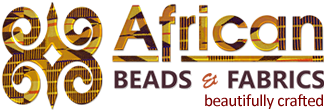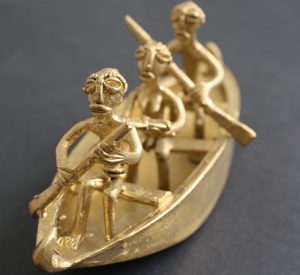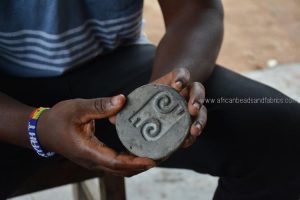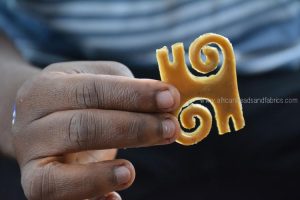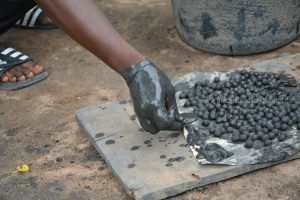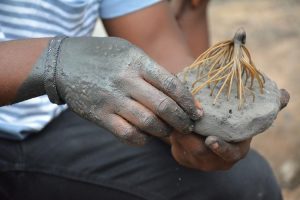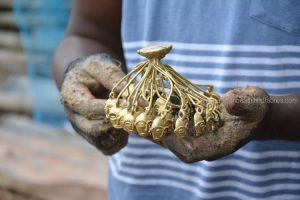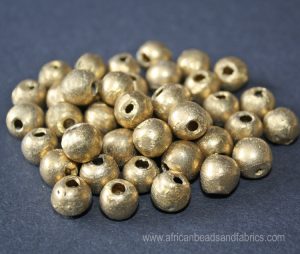Introduction
Brass casting in Ghana goes back many centuries and is believed to have been imported from the Arab world through early contact in trade across the Sahara desert. In modern times a major centre of brass bead-making is Krofofrom near Kumasi in the Ashanti Region of Ghana.
The technique can be used to make a variety of products including beads, rings, masks, earrings, necklaces, bracelets, pendants, hangers, drawer handles, decorative pieces and trophies.
- local canoe ornament
- ornament depicting a cultural procession
- traditional drummer
The “Lost-Wax” Technique
The method for casting brass used by the artisans in the Ashanti Region of Ghana is known as the “lost-wax” method. This involves making a model from beeswax which when heated melts, leaving a cavity which can be filled with molten metal, in this case brass. This technique has been used for centuries by the Ashanti people.
- beeswax
- beeswax moulds
- handmade beeswax strings
In researching this article we visited a producer of brass products based in the Ashanti Region. The proprietor and has been in this industry for many decades working with his two sons and a number of apprentices. The art of brass product-making has largely remained a traditional skill handed from generation to generation. Apprentices in brass works do come from far and near to learn the trade. The Art Faculty of the Kwame Nkrumah University of Science and Technology in Kumasi collaborates with these local producers mainly through internships, practical assignments, visits by faculty members and research.
- master craftsman & owner
- owner’s son and junior craftsman
- apprentices come from far and near
He sells his products to buyers both in Ghana and abroad and there is increasing interest abroad for his products and attends exhibitions regularly; such is the quality of his work
Brass Product-Making
Old and broken brass objects such as taps
- taps
- pipes,
- old padlocks,
- door handles, etc.
are recycled.
The first step in the making of brass products using this method is the creation of a wax model. The wax is softened by placing in warm water and pressed into the mould to create the model and excess wax is cut away. The wax model is carefully taken out of the mould. Finer details of the model can be created by hand using wax.
- a mould ready for the beeswax
- simple handheld tools are used to create the moulds
- the perfect result!
This then goes through a number of coatings whereby layers of clay, mixed with charcoal are applied to the models in stages. The layers are allowed to dry between coatings.
- first coating of charcoal mix
- second coating covers a batch of items
- final coating and ready for the kiln
Before the final coating is applied, wax tubes are inserted into the wax models and brought together at the top to form a hollow vessel which will later be used for pouring of the molten brass.
The final coating of clay and palm fibre is applied and allowed to dry, leaving a hollow at the top as a channel for the brass.
- wax tubes go in before final coating…
- … and bunched together
- the wax tubes carry molten brass to the moulds
Casting
The moulds are placed in a kiln and heated to melt the wax, then molten metal is poured into the hollow at the top of the mould and through the wax tubes to fill the space created by the melted wax models.
An alternative method of casting is to put the pieces of metal in a vessel under the mould and heat both the metal and the wax at the same time. When the molten metal is obtained the mould can be turned upside down to allow the molten metal to run through the tubes and into the space left by the wax models.
Post-Casting
When the casting process is complete, the moulds are allowed to cool and are broken open to reveal the brass casts. The tubes are cut off the products and can be reused in future casts. Any rough and unwanted bits can be removed using an electric grinder. The casts are cleaned to remove the black core. The last stage is to wash, polish then and are then ready to be sold and used for a variety of jewellery and other crafts.
- elephant brass bag charm/key ring
- adinkra brass pendant necklace
- bracelet wth brass and glass components
Video
You can see the processes involved and more via this link:
https://www.dropbox.com/s/ov4wq1lpbwprmlm/BRASS%20MAKING.mp4?dl=0
Reference
Simak E and Dreibelbis C (2010): African Beads: Jewels of a Continent: Africa Direct
Interviews with brass craftsmen
Examples of Brass Items in our stores:
- elephant pendant
- round, plain beads
- bracelet bars
- spiral flat beads
- “Ananse ntentan” (adinkra) pendant
